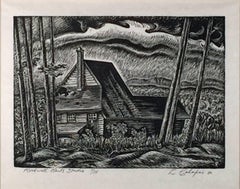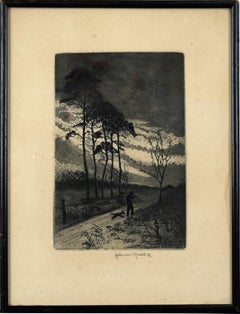Letterio Calapai. 1902-1993. Landscape Prints
As American art of the 1930s and 1940s has become increasingly sought after, Letterio Calapai’s wood engravings have been rediscovered, and there is a growing realization that he was among the more distinguished artists working in this idiom during this period. Born in Boston, Calapai studied at the Mass. School of Art, the Art Students League, and the American Artists School. He was a student of Robert Laurent, Ben Shahn, and Stanley Hayter. From 1949–55, he was chairman of the Graphics Arts Department at Albright Art School at Buffalo and taught at the New School in New York from 1955-62. He was the founder and director of the Intaglio Workshop for Advance Printmaking in New York from 1960–65 and then became a professor of art at the University of Illinois.
(Biography provided by Harris Schrank Fine Prints)1980s American Realist Letterio Calapai. 1902-1993. Landscape Prints
Engraving, Woodcut
Early 20th Century American Realist Letterio Calapai. 1902-1993. Landscape Prints
Paper, Ink, Drypoint, Etching
Mid-20th Century American Realist Letterio Calapai. 1902-1993. Landscape Prints
Drypoint, Etching
1870s American Impressionist Letterio Calapai. 1902-1993. Landscape Prints
Engraving, Woodcut
2010s American Realist Letterio Calapai. 1902-1993. Landscape Prints
Screen
1980s American Realist Letterio Calapai. 1902-1993. Landscape Prints
Etching
1850s Victorian Letterio Calapai. 1902-1993. Landscape Prints
Woodcut, Engraving
Mid-20th Century American Realist Letterio Calapai. 1902-1993. Landscape Prints
Drypoint, Etching
1930s American Modern Letterio Calapai. 1902-1993. Landscape Prints
Woodcut, Engraving
1870s American Impressionist Letterio Calapai. 1902-1993. Landscape Prints
Engraving, Woodcut
21st Century and Contemporary American Realist Letterio Calapai. 1902-1993. Landscape Prints
Mezzotint
1870s American Impressionist Letterio Calapai. 1902-1993. Landscape Prints
Engraving, Woodcut
1930s American Realist Letterio Calapai. 1902-1993. Landscape Prints
Woodcut
1940s American Modern Letterio Calapai. 1902-1993. Landscape Prints
Engraving, Woodcut

